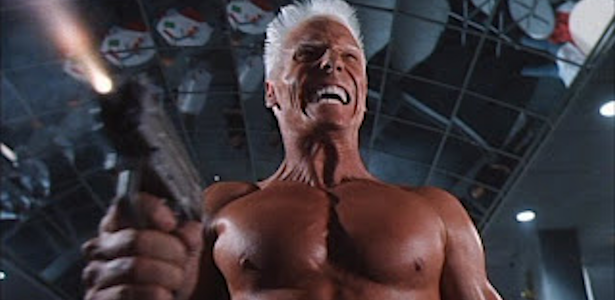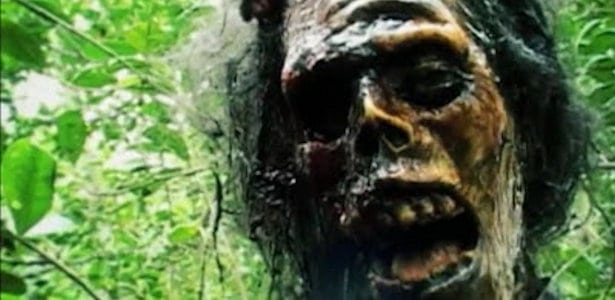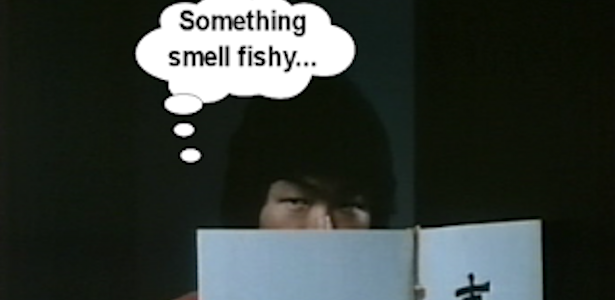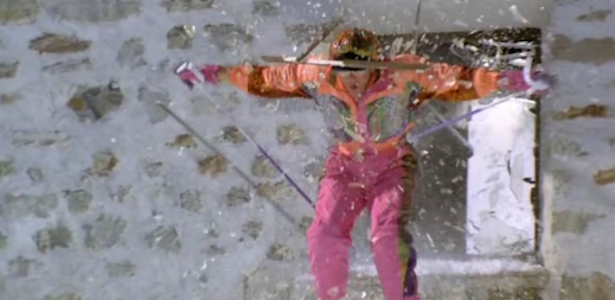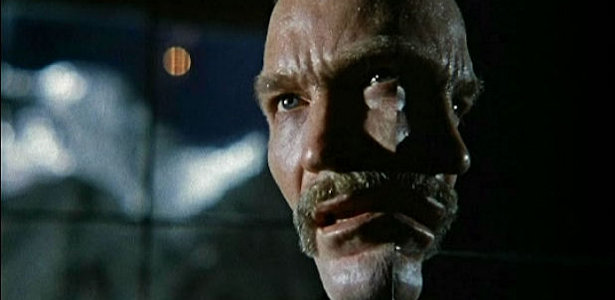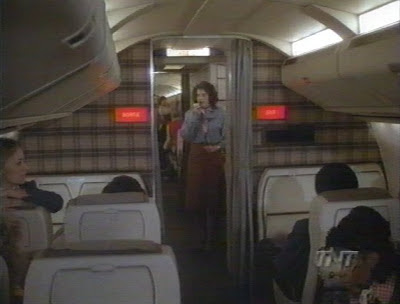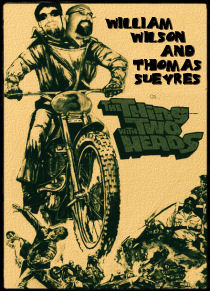Enough time has passed and the intense rehab on my frame-grabbing arm went well enough that it is time to tackle another case of extended TV versions. As they did with
EARTHQUAKE (1974) and
TWO-MINUTE WARNING (1976), Universal opted to shoot new footage for the final entry in the popular AIRPORT series for its debut on network television in May of 1982. Chris Poggiali from
Temple of Schlock was kind enough to hook me up with the longer version of THE CONCORDE…AIRPORT ‘79. In retrospect, I suspect his main goal was to kill me as this is easily one of the most complex cases of extended footage I’ve seen. The film cuts scenes, rearranges scenes, reinserts deleted footage from the original shoot, and adds newly shot footage for the TV premiere. Keeping track of all that is enough to make you feel like Michael Ironside is scanning your brain.
It seems only fitting that the popular disaster film genre of the 1970s would see its collapse with an AIRPORT entry. After all, the original AIRPORT (1970) is the one that kicked the subgenre off. Audiences in America flew into theaters to witness edge of their seat thrills to the tune of $100,489,151 in box office dollars (adjusted for inflation that would be $524,963,200 in 2013), making it the second most popular film that year behind LOVE STORY. Two subsequent sequels, AIRPORT 1975 and AIRPORT 1977, proved to be less successful, but still ranked in the top 20 gross lists of their respective release years. By the last couple of years of the decade, however, audience interest in star-studded disaster epics was deteriorating thanks to fantasy films like STAR WARS (1977), CLOSE ENCOUNTERS OF THE THIRD KIND (1977) and SUPERMAN (1978). Universal had even eclipsed their own action film benchmark with the popular SMOKEY AND THE BANDIT (1977). But keeping studio execs away from a proven money making formula is like stopping Tom from watching Aussie movies. It ain’t gonna happen.

With the cutting edge Concorde being made available for commercial flights beginning in 1976 after a decade of testing, you knew it was only a matter of time before someone cashed in cinematically on this one of a kind, supersonic airplane that caught the public’s attention. My own personal fantasy is a bleary-eyed Universal exec returning home from a tough day of watching dailies for THE WIZ (1978) and seeing a television news report on the Concorde. “We’ve got an airplane series, it’s perfect,” he screams before falling asleep in his beanbag chair. In reality, MCA/Universal vice president Jennings Lang announced the production in May of 1978 after taking several trips to Europe to get permission to use the sleek bird.

As expected, a large ensemble cast was collected with a bigger emphasis in international appeal by the casting of French icon Alain Delon as the plane’s captain and sexy symbol Sylvia Kristel, fresh from the EMMANUELLE trilogy, as a stewardess and love interest. On the American side, Robert Wagner was cast as the villain and AIRPORT stalwart George Kennedy returned as inexplicably upwardly mobile Joe Patroni, who has gone from a mechanic to pilot over the four-film series. Filming began on November 16, 1978 in France for two weeks and then continued over to Washington DC and Los Angeles over the next month. Lang was so sure that the film would be a hit that he announced his next disaster projects – a sequel to EARTHQUAKE and THE WAVE – on January 26, 1979.

Audiences, however, had a different feeling and were de-pressurized to the series. The film had its world premiere on August 1, 1979 in Monte Carlo with stars Delon, Kennedy and Susan Blakely in tow and slowly started rolling out in the US over the month. Unfortunately, it was no match for the film currently at the top of the box office – THE AMITYVILLE HORROR (1979). This true life terror tale was scaring the dollars out of audiences’ pockets and yelled the box office equivalent of “get ooooout” at the Jennings Lang production. Although the film stuck around until the end of October and got a small reissue in December, it collected a mere $13,015,688 in domestic sales. Not only was it a series low, but it was less than the film’s $14 million dollar production budget.
Following television airings on pay channels, the network debut of THE CONCORDE…AIRPORT ’79 took place nearly three years later on Monday, May 17, 1982 on ABC in a three-hour (8-11pm) timeslot. Taking flight during the coveted sweeps period, the producers were up against NBC’s big budget, four-part miniseries MARCO POLO, so once again new footage was shot to pad out the feature’s length (my research indicates most of this new footage was shot in July 1981). In total, just over 21 minutes of new footage was added to the original film. For the sake of a lucid article (and my sanity), I’ll only cover the added and deleted footage and not go into great detail on the reshuffling of scenes in the television version. Anyway, fasten your seat belts as this is going to be a bumpy ride!
TV Guide write up on the film, May 1982:
Anyone intimately familiar with AIRPORT ’79 (my condolences) will notice changes right off the bat as the plane’s near collision with protestors in a hot air balloon is moved from the opening to nine minutes into the film. The first major new footage occurs just six minutes into the film as there is a scene of bad guy Kevin Harrison (Robert Wagner) visiting the ghetto for a building dedication. It opens with him playing some basketball with some kids. He gets some high fives (!) before his winded self reveals he is getting to old for this and someone comes to tell him the Mayor is waiting.


A young kid then asks Harrison for his sneakers back. They sit on a park bench and the kid asks, “You really the richest man in the world, Mr. H?” Harrison says not in the world, just America. Ah, humble. The kid then asks if he has all that money whey he doesn’t have any tennis shoes and Harrison replies, “Because I can borrow yours.” Harrison then confides in the kid he isn’t even prepared for his speech and says, “When in doubt, fake it.”
They get up and are accosted by reporters. When asked how he likes the place, the kid says it is okay and Harrison needles him to get a phony response and the kid says he loves it and loves Mr. H. They then smile for the press.
Can you see how weird this is going to get? Remember, Harrison is the villain in this film and this new 2-minute scene shows him having sympathy for inner city youth.
It is then around the 9 minute mark that we get the air balloon scene. Not only do they remove the air traffic controller saying “Holy Christ” when he sees it, but there is also about a minute of extra footage of airport security getting the balloon down by shooting a hole in it.
We then get the introduction of the newswoman Maggie Whelan (Susan Blakely) in the studio. Following her talk about the balloonists, the Concorde’s flight to Moscow, and the Harrison Industries Buzzard drone project, we get a new dialogue overlaid where she says that Harrison currently lives in Washington DC with his wife and three children. This segues into new footage of Harrison in his home talking (“Go ahead, this is a safe phone. We’re on the scramble device.”) with his henchman Cooper (Conrad Palmisano) regarding documents that were to be shredded. Harrison gives him the go ahead to “terminate” Carl Parker, the man who stole the docs, in order to hide them from the press.
We then get a new bit back at the studio with Whelan stating to her viewing audience that she will also be on this Concorde flight.
Up next is some extended footage in the love scene between Capt. Paul Metrand (Alain Delon) and Isabelle (Sylvia Kristel) in the hotel (they definitely didn’t bring them back for new stuff). Instead of opening with Delon telling her that he won’t hurt her again, the scene opens with him telling her she still has the most wonderful laugh and that he missed her. It begins to rain and she gets up to close the window. She then notices a book of his and asks him to read her something (“The tender friendships that one gives up, on parting, leaves a bite on the heart, but also a curious feeling of a treasure somewhere buried.”).





Following the rearranged arrival of Joe Patroni (George Kennedy), we get the longest new footage so far as there is a three-and-a-half minute scene of Mr. Harrison and Maggie Whelan in bed together. She says she loves him and he says she is “violating a cardinal rule of adultery” to never fall in love. She mentions how she hated growing up as a diary farmer’s daughter with so many rules and then drops the bomb on him – she’s pregnant.
As you can see, he’s obviously thrilled when she says she wants to keep the baby. This adds a new element to the film and his later attempt to blow up the plane with a missile. Yes, it is the world’s most expensive abortion. Her pocket watch then goes off to let her know it is time to split.
He tries to convince her to stay and go to his awards show, but she thinks a mistress in the room with his wife and three kids is a bit tacky. Maggie then gets a phone call and it turns out to be Harrison’s wife. He sheepishly gets on the phone and the female voice on the other end wants to know if this is Rocco’s pizza or not. Oh, Maggie, you cad!
Our next bit of extra business is when Patroni shows up at the hotel and decides to knock on Metrand’s door and introduce himself. There is an extra shot of the couple in bed and she scurries away saying, “I don’t want to be seen with you.” You and me both.
The television version finally gets down to the Carl Parker subplot as the whistleblower shows up at Maggie’s place. Interestingly, the TV version has extra shots of her in the bathtub.
After the assassin disposes of Carl Parker and chases Maggie around her house, there are extra shots of him sneaking around her bedroom before he goes upstairs.
Following her narrow escape, Maggie seeks comfort with Harrison as they walk around DC. Here you actually get a 40 second scene were Harrison puts her into the limo and wishes her off.
After he sees her off, he goes to his own limo and talks with his co-conspirator William Halpern (Robin Gammell) as in the theatrical version. Following that is a new added bit involving the countdown to the firing of the test drone. It is made up of footage from the theatrical release and is used quite a bit by through the extended version as a tension builder before commercial breaks.
The film continues on with the build toward the plane’s takeoff. A couple of interesting omissions happen here. The Russian team hijinx as they board the bus are removed. Also, when Kennedy and Delon are heading toward the plane, the TV version zooms in when Kennedy makes the motion of big breasts while telling a story. Later they remove his line “that’s why they call it a cockpit” and his sex-filled wing walker story. So, TV Joe Patroni isn’t as big a perv.
Around the 38 and half minute mark of the TV version, there are two new scenes back-to-back that appear to have been newly shot footage. First, you have Robert Palmer (John Davidson) talking with his secret Russian gymnast girlfriend Alicia (Andrea Marcovicci) about not going on the flight so she can defect and get married. She says it would be too hard on her family back in Russia and leaves him to get on the bus (which doesn’t match the bus in the earlier AIRPORT ’79 scenes, hence my belief it is newly shot).
The second new scene takes place in a hospital as a doctor tells Mrs. Gilbert (Cicely Tyson) that they are ready to move the human heart for her son’s transplant. When she asks how long the heart (in a box clearly labeled “human heart” in bold, LOL) can last, the doctor says, “We have to be in Paris in six hours.” They then jump into a helicopter on the roof and take off.
For the arrival of most of the passengers, the TV version uses a different shot of the bus unloading folks at Dulles.
Things proceed as normal as Harrison and Maggie say goodbye and Maggie gets the documents from Carl Parker’s wheelchair bound wife (more on her in a bit). Once onboard the plane, we get introduced to the passengers in roughly the same fashion. There is an extra scene of Sylvia Kristel consoling a young female gymnast who is cracking under the pressure of her first trip away from home and the stress to win the gold. She tells her to think of it as an adventure and how lucky she really is. Sylvia gets her some tissues and says to a fellow stewardess, “They expect 14-year-olds to be mature women. It’s a pity, childhood is short enough.”
Is that Jason Lively? (Tom: "No, it's Robin Askwith!")
Following John Davidson showing up to declare his love, there is an extra bit of dialogue between the Russian coach and Alicia. The coach says she knows the girl’s performance is suffering because she is in love. She too had a chance like that with a Swedish swimmer. When asked why she didn’t take it, she says, “Because I’d have to live my life in exile.”
Before the plane takes off, Maggie gets up and says she needs to make an urgent phone call. Good lord, the drama for the young ladies is getting piled on here.
She finally gets in touch with Harrison and lets him know that she has the documents and has seen them. There is some extra dialogue here where Harrison uses his charm to keep her from exposing him
Him: “I was just thinking about that trip we made to Maine. Remember how cold it
was? I think we spent the whole week in bed. It was like a honeymoon for us.”
Her: “The honeymoon is over.”
In both versions, however, she concedes though and ends with “I’ll see you in Paris.”
It is hard to believe that we are only now getting to the plane taking off. Once in the air, both versions are pretty much the same for a period of time. Not surprisingly, the TV version edits out the shots of Jimmie Walker smoking a joint in the bathroom. As a result, it makes it looks like he just plays his sax so much that it causes big clouds of smoke to surround him. We then get the thrilling near miss with the drone.
It is now that a huge chunk of the newly shot material begins appearing. Obviously shooting new footage inside the plane would be a continuity and logistics nightmare. So where did the producers go? Why to the ground, of course. If you are still with me (thank you!), you might recall me telling you to keep the wheelchair bound Mrs. Parker (Kathleen Maguire) in your minds. Well, she is back and telling the cops that they need to investigate Harrison for her husband’s murder. This four minute scene establishes one of the main storylines in the newly shot footage – a ground investigation of Harrison that spans two continents. Also, it has the best line where Mrs. Parker says, “Stop treating me like I’m an emotional cripple!”





Lt. John Ratcliff (J.D. Cannon) asks for some sort of proof because he needs evidence and Mrs. Parker says to talk to Maggie Whelan. The cop says he did and she offered nothing. Then Mrs. Parker says of course she didn’t because she just gave her the evidence at the airport today. Think about that for a second – this new subplot has a woman who just gave away her best evidence going to the cops. Anyway, she gets angry that he isn’t taking it seriously and demands to see his superiors (“I’ll see the President himself if I have to,” she cries). Lt. Ratcliff calls in a dude and has her wheeled out.
He apparently did that just because he likes making women in wheelchairs hysterical because right after she leaves, he jumps on the phone and asks for everything they have on Kevin Harrison (“That’s right, the Kevin Harrison.”).
After Harrison speaks to his French baddie friend Robelle (Jean Turlier), we get more new footage with the FBI getting involved now. Ratcliff calls an FBI agent (Alan Fudge) and says, “We’ve got a case here in the District that may involve your department too.” He gives the details and says that Parker’s widow gave a statement and “it reaches pretty high up.” Wait, didn’t you just force her to march…er, wheel out of your office? Regardless, the Feds are now on the case.
Back on the plane, we get a new bit where Delon tells the passengers their location and tells them to look outside to see the curvature of the Earth. We cut to Maggie looking outside and then she is shown putting the documents back into her bag.
During the sequence where the Concorde is fired upon by the rogue fighter, there is extra dialogue between Delon and Kennedy. After Kennedy spots the fighter plane, Delon asks, “What’ he carrying?” Kennedy says, “Four heat seeking air-to-air missiles. Range six miles at Mach 2 point 5.” Goddang, not only is Patroni an adept social climber, but he has the eyes of a hawk.
During the insane getaway, the producers of the new footage felt that they needed to insert shots of pipes bursting during the Concorde’s flip for some reason (“The hydraulic system has been hit!”).
There is also a bit where John Davidson saves his Russian love as she is thrust from her seat.
Following ample disaster hysterics (the Concorde dodging missiles and a crash landing), we finally arrive in Paris. But this craziness is only getting started. We now get another new scene involving the investigation and jump to INTERPOL and the office of Charles Davenport (George Innes). If there is one man for the job, it is Charles Davenport in room 305.
An associate (Ben Piazza) enters the room and fills him in the Harrison case details. Davenport is obviously the serious type given his beard and map with pins in it. His buddy tells him Harrison and his businesses have all been under surveillance for some time. Davenport says to relay Washington their info. The guy leaving says he is getting coffee and Davenport asks for tea. He's British, we get it!
Okay, are you still with me? If so, I’m sorry. Anyway, prepare yourself as now we get the monster of new footage added to the film, nearly 13 minutes worth! First, we have Harrison’s henchman Cooper (who somehow also arrived in Paris) breaking into Maggie’s dressing room at the studio where she is about to go live. How do I know this? There is a PA announcement that saying the broadcast will begin in 30 minutes. I like that Mr. Incognito knocks first before break in. I also like that he is searching for a bunch of documents and the first place he looks is a petite handbag.
Meanwhile, the total pro Maggie is already on the air telling how she survived the harrowing ordeals on the Concorde and plays her audio tape of the incident for audiences.
Harrison shows up as promised. She doesn’t look thrilled to see him and his pinky ring.
She gets up to meet him outside the studio and they hug (“I’m so glad you’re alright,” he says). They talk and she hits him with the one-two combo of “You lied to me” and “How far would you go to protect yourself?” But he battles back with the classic “I would never do anything intentional to hurt you” before asking if she still has the documents. She says security has them locked up. Foiled!
Back in the dressing room, the guy is still looking for stuff when a security guard arrives with flowers for Maggie. The security guy places the flowers down and then eyes the guy suspiciously before seeing a handbag on the floor. The guard picks it up and…places it on the table. Qui, that was a close one.
He then checks the card on the roses (why, the documents ain’t in there) and sees they are from Kevin Harrison.
There is then a new scene with Harrison’s associate William Halpern meeting up with the French bad guy Robelle in a hotel. Frenchie apologizes for the fighter plane fiasco and then questions whether they should have had Cooper come over since he botched the Parker job. Yes, in a world of billions, Harrison likes to only deal with 2 or 3 of the same guys. Halpern says, “I promise you we will deal with the situation properly.”



We then get new footage in a hotel lobby with Concorde honcho Eli Sands (Eddie Albert) and his wife Amy (Sybil Danning). You go Eli! I have to respect anything that gives me extra footage of Danning. He asks her what is wrong and she mentions how she doesn’t want to make the next flight on the Concorde to Moscow and is frightened. He says he has to go as he is the top guy and “how would it look if I chickened out?” He reassures her by saying people think the terrorists “have shot their wad” and won’t try again before telling her that she’s “the best thing that ever happened to me.” You and me both, Mr. Albert! He then says he will take her shopping in the morning because the plane needs a little more time for repairs. Oh, and the INTERPOL people want to talk to them in the morning.






After that is another new sequence between Maggie and Harrison as they walk on a bridge in Paris. Harrison talks about his past and how he got into the weapons trade. He gives a strange “right hand of God/left hand of God” speech. He even points out a guy drawing street art and says, “There is a man who understands life. Nothing is permanent.” Yes, dudes who fill the world with weapons long to have the philosophy of a street chalk artist. Okayyyyyyyyyy.
Their conversation then moves to down by the water. Maggie asks Harrison what he is going to do and he says he will hold a press conference and confess everything. He then buys some flowers from a little old lady and gives them to Maggie. He says, “I want to change my life. You’re a big part of it now.”
This scene is really tricky in terms of deciding if it is new or shot for the original release. It reeks of newly shot footage given the wishy-washy character intentions of Harrison. However, would they really fly them over to Paris just to shoot one new scene? (edit: actress Susan Blakely has confirmed to us that this was scene was from the film's original shoot.) Wagner’s hair is a bit different from the original shoot and I wonder if they were trying to soften his character given the popularity of HART TO HART at the time. Either way, this scene isn’t in the theatrical version.
Meanwhile, we cut back to Cooper who is now going through Maggie’s hotel room. After a bit of searching, he calls down to the front desk pretending to be her manager (do news women have managers?) and says he needs to put some of her papers with other stuff she gave them for the safe. However, his ruse doesn’t work as they said there is no record of her putting anything in the safe. Foiled again!
After we go through all of the romantic bits (including Delon hooking Kennedy up with a prostitute!), we get more new footage back in Washington DC. Lt. Ratcliff is in the office of his FBI buddy and they discuss what is going on with the case. The FBI guy tells Ratcliff to keep his cool as Mrs. Parker’s statement has been sent to the Attorney General and Treasury has sent their info on Harrison to Interpol. New scene, thy name be exposition.




Immediately following this scene is new footage of Eli Sands and his wife meeting Chief Superintendent Morabito (Jose Ferrer) of INTERPOL. When Sands asks why they are interested in what happened with the plane, the Superintendent says that they are more interested in Kevin Harrison and asks Sands if he knows him. When told of his nefarious connections, Sands defends Harrison as “one of our top people” and that the Chief is “barking up the wrong tree.” Then Amy says that the only connection Harrison has to the Concorde is one of its passengers *wink, wink*. She then spills the beans on Maggie and Harrison.
After the Sands leave, Morabito gets on the phone to Davenport to talk about the case. He stresses that “we must check out every lead, no matter how trivial.” Davenport complies due to Morabito’s beard seniority. Davenport then rings his secretary and says, “Washington, please.”
A few scenes later we see more new footage. In the theatrical version, a mechanic (Jon Cedar) sabotages the Concorde’s wiring system and later attempts to escape with the money taped to his body. In the TV version, his role is expanded and we see him meet Mr. Robelle in the mechanics shop to get the money. He is also given a plane ticket and told his services would no longer be needed…EVER!
After everyone has boarded the Concorde for the second time, there is a quick extra scene of Kristel telling the passengers that the boy’s heart transplant was a success and the little boy is doing fine. Everyone applauds in response.
Unfortunately, this section also has an omission that I’m sure will hurt everyone. I don’t know how to break it to you guys, but the entire scene from the theatrical version with Charo trying to smuggle her dog onboard has been removed. While scenes were altered/removed for adult content, this is the only scene removed outright. I guess ABC knew the world wasn’t ready for primetime cuchi-cuchi.
Did you think we were done? Not quite. The producers of the new footage saved the best for last. During the aforementioned George Kennedy/prostitute courtship, he woos her at the dinner table by telling her his wife died in a car wreck and he has a college age son. They decided to shoehorn that into the film via a flashback, which is done by just zooming into Kennedy’s head. Dissolve to cheap sitcom set where Kennedy is having breakfast with his family.
Son Joe, Jr. mentions he’s finished his tea and his mother gets all excited. Dad pleads for him to let his mom Helen (not played Susan Clark from AIRPORT 1975; in fact, it is Jessica Walter, who has a completely different eye color) indulge “in her only vice” which is – I kid you not – reading his tea leaves. Obviously, Joe, Jr. has a bright future and a new love on the horizon according to mom, but a dark shadow is over someone near you. Pop kids his wife about her half-English, half-gypsy heritage.
Naturally, the time comes to read Joe, Sr.’s tea leaves and, you guessed it, shit is looking bleak. “There is some kind of machine with an engine that’s crushed. There is death surrounding you,” she says. She pleads with him not to take a flight to Chicago. He dismisses her tea leaf reading as just a hobby and assures her he will be fine.
Cut to Patroni walking down a hospital corridor and meeting with a doctor. The doc explains that his wife got in a car wreck with a drunk driver and is in serious condition (“She has brain damage and can’t talk, but there’s no pain.”). OMG! The tea leaves were right…but it wasn’t about him…it was about her!
This nearly six minute new scene ends with Patroni going in to the hospital room and checking out his wife. He kisses her and she wakes up. He tells her that they are going to “fight this and beat this.” Seems his prediction skills aren’t as good as hers. We then cut back to the theatrical version where Metrand asks Patroni what’s up and he says he was just thinking about his wife. Well played, TV producers, well played.
Back in Paris, there is a new scene with Robelle talking to Harrison on the phone. He informs him of the mechanic’s accident and that INTERPOL will be questioning him. Also, he’s heard the authorities know about Maggie and the documents. “Try to save your self, my friend,” Harrison says over the phone before they hang up.
The path to the film’s final Concorde disaster is pretty much the same. However, there is a 40 second bit of extra footage in the cockpit where the plane tips forward and Delon says, “She nosed.”
The plane eventually crashes in the snow in the mountains and things are pretty much normal. Well, except Maggie goes live on the air to cover it. Is she the world’s only news reporter? She explains that Halpern hung himself and Robelle was arrested by Paris police. And what has happened to her hunky beau Harrison? A warrant has been issued for his arrest.
Cut to Harrison watching this in a hotel room. He gets up from his chair and goes over to his briefcase, where he pulls out a gun. He goes into the hallway where a bunch of reporters are there. When asked if he has any statement, Harrison says, “Just tell them I’m in the left hand of God.” He then shoots himself. This “left hand of God” line actually refers to the earlier Maggie/Harrison Paris walk.
This new suicide replaces the earlier scene in the theatrical version where Harrison commits suicide on his own plane while watching Maggie’s report from the scene of the plane’s crash landing.
The film then ends with Maggie summing up the events as she addresses the camera.


Holy Patroni! Did I just spend nearly 5,000 words typing up AIRPORT ’79? And grab over 150 frame grabs? My mom would be so proud. If you’ve made it this far, I congratulate you and hope I was able to showcase what a maddening task this was. I have seen plenty of TV versions with alternate footage/new footage, but I am firm in my belief that this is easily one of the most complex versions ever made. We've never been able to decipher who wrote and directed this new footage (edit: co-star Sybil Danning has confirmed to us that original helmer David Lowell Rich also directed the additional TV footage). In the end, however, it paid off for Universal. Despite the poor box office and the later parody AIRPLANE (1980) having put an end to the airplane disaster series, this TV version of THE CONCORDE…AIRPORT ’79 came in tenth place in that week’s ratings with 18.3 million viewers and a 31 share of the viewing audience. It proved that AIRPORT fans were still out there, but that they just didn’t want their faces seen in public. Now, what is the number of my frame grabbing physical therapist again?
Special thanks to Chris Poggiali for supplying the TV version plus the push over the edge to actually do this and TV sleuth Marty McKee for identifying some of the actors in the new footage.
Also, thanks to George White at www.ateenagersguidetotrash.blogspot.com for painstakingly finding out who played Davenport.



